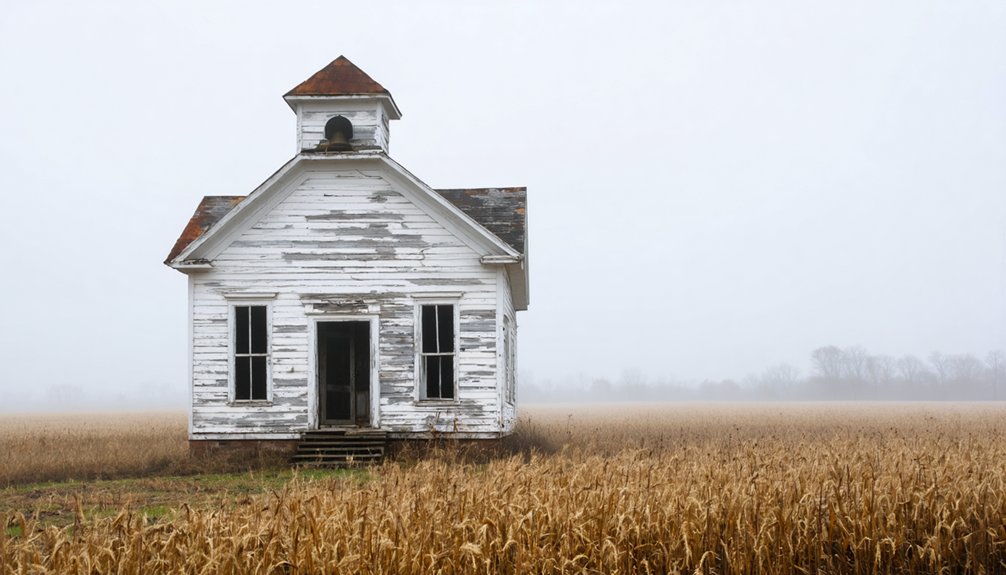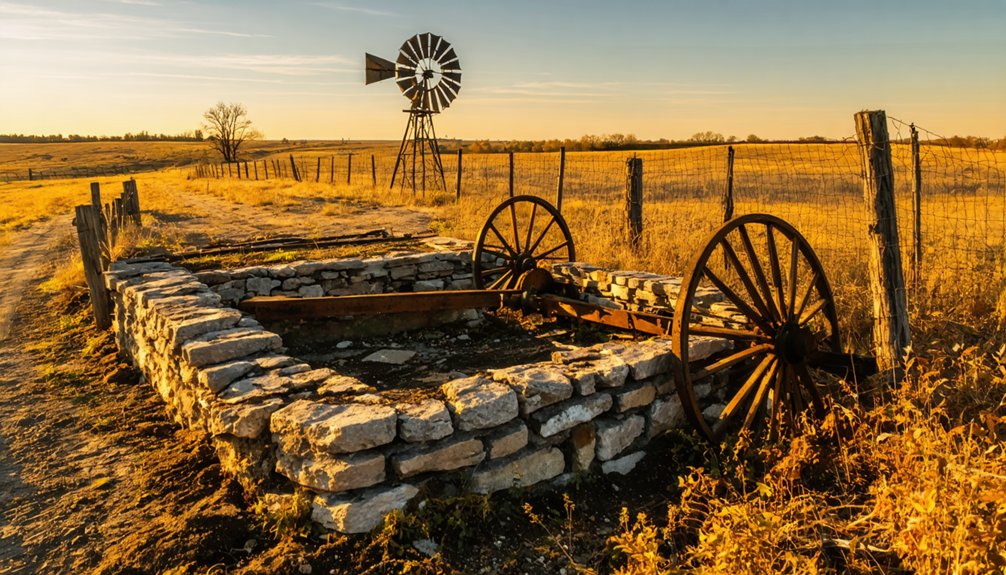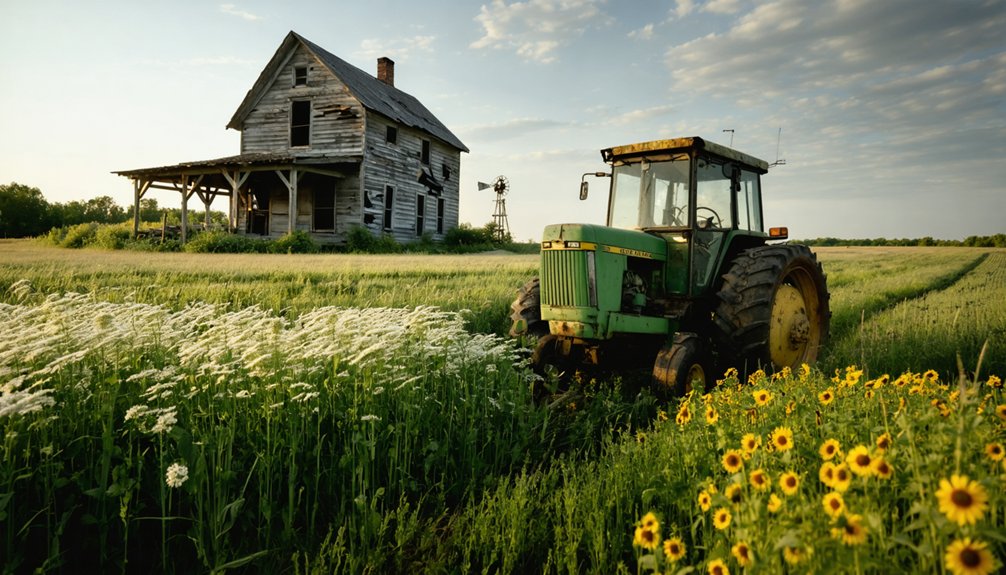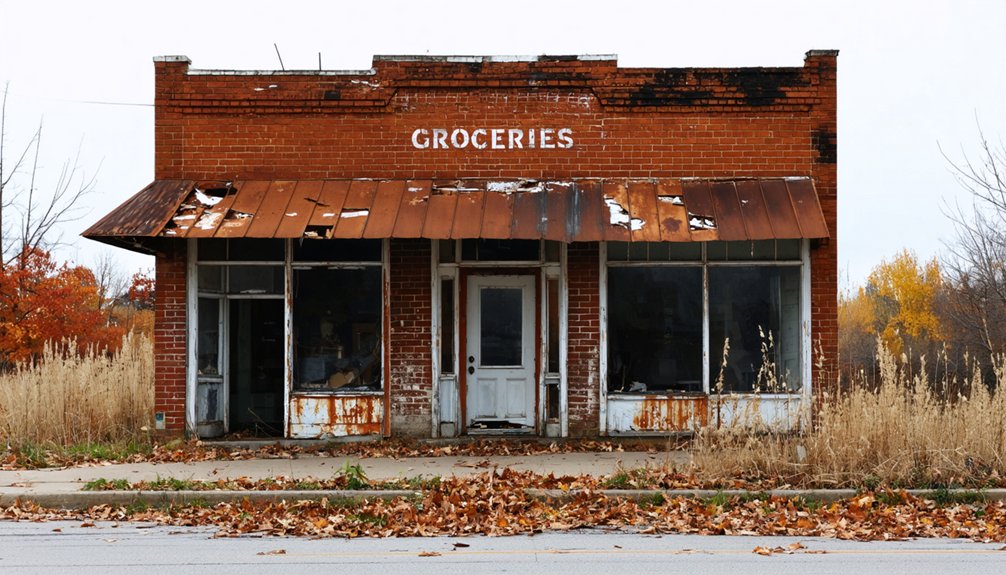You’ll find Green Valley’s abandoned streets and buildings along Iowa’s historic rail lines, where a vibrant agricultural community once flourished. During its peak in 1940, the town boasted 391 residents who worked the fertile soil, operated grain elevators, and built strong community bonds through local schools and churches. The town’s decline came with agricultural mechanization and railway changes, but its preserved legacy offers important insights into Iowa’s pioneering spirit.
Key Takeaways
- Green Valley reached its peak population of 391 residents in 1940 before declining due to agricultural changes and diminishing railway importance.
- The town’s abandonment resulted from young residents moving to cities, farming mechanization, and closure of essential services like schools and shops.
- Originally established near railroad networks, Green Valley thrived on agricultural trade and mining operations in Iowa’s frontier period.
- The community’s infrastructure fell into disrepair as population loss made maintenance impossible, leading to eventual abandonment.
- Green Valley’s legacy continues through historical records, archived maps, and family histories documenting Iowa’s pioneer settlement patterns.
Origins and Early Settlement
Three distinct forces shaped the birth of Green Valley: the expanding railroad network, promising agricultural prospects, and Iowa’s burgeoning mining industry.
You’ll find that Green Valley’s settlement patterns followed the typical path of many Iowa frontier towns, strategically positioned near crucial transportation routes and natural resources. Many towns that followed this pattern would eventually become ghost towns as economic conditions changed.
As the community took root, you would’ve witnessed the rapid development of essential community structures. A schoolhouse, church, and post office soon dotted the landscape, serving as gathering points for the town’s tight-knit population.
Early settlers capitalized on the region’s fertile soil, while others found work in nearby mining operations. The railroad’s presence guaranteed steady commerce, connecting Green Valley’s agricultural and mineral products to broader markets. The town’s mining camps drew transient populations of workers seeking employment opportunities.
These economic foundations initially promised a bright future for the fledgling town.
Pioneer Life in Green Valley
While carving out a life on Iowa’s expansive prairies, Green Valley’s pioneers faced unique challenges that required remarkable adaptability and community support.
You’d find pioneer families working together to overcome the scarcity of wood, building homes from available materials and sharing resources when winters turned harsh. Breaking through the prairie’s dense root system required multiple teams of oxen to effectively plow the land. They’d gather for harvest festivals, strengthening community bonds that proved essential for survival.
These settlers learned to master the art of growing corn and wheat in the rich soil, though they’d constantly battle unpredictable weather. Living in simple wood structures inspired what would later become the iconic American Gothic painting.
When roads were nearly impassable, neighbors relied on each other for everything from barn-raising to medical care. As the railway arrived, you’d see their persistence pay off – Green Valley’s pioneer families could finally transport their crops more efficiently and maintain stronger connections with the outside world.
Economic Development and Trade
In Green Valley’s early days, you’d find a bustling business district where local farmers brought their grain, livestock, and produce to market while merchants operated general stores and blacksmith shops to serve the community’s needs.
Similar to the mining communities that sprang up across western states in the 1880s, the town experienced rapid initial growth during its development.
Your ancestors built strong trading networks with neighboring settlements, exchanging agricultural goods and establishing seasonal markets that drew buyers from across the region.
The town’s economic importance peaked when the railroad enabled local products to reach distant markets, though this prosperity would ultimately prove temporary. Like many settlements of that era, Green Valley’s fate was tied to its ability to achieve economic diversification beyond a single industry.
Local Markets and Commerce
Green Valley’s economic backbone centered around a diverse network of local markets and specialized industries during its heyday. You’d have found a bustling marketplace where local goods flowed through general merchandise stores, offering everything from dry goods to essential supplies.
Market trends shifted as the town’s merchants adapted to serve both residents and travelers. Similar to the successful operations at Buckhorn Creamery, the town’s dairy processing facilities played a vital role in regional distribution. The merchants’ commitment to authenticity required security verification of all major trade transactions.
The town’s commerce hub featured specialized services like wagon shops and grist mills, which processed grains for local and regional trade. You could’ve witnessed butter production facilities contributing to the area’s economic significance, while post office operations kept communication lines open from 1873 to 1903.
The community’s trade networks extended beyond its borders through ferry services and, later, steel bridges, connecting Green Valley to larger regional markets.
Agricultural Trade Networks
Agricultural trade networks transformed the economic landscape of Green Valley far beyond its local marketplace activities. As railroads arrived in the 1850s-60s, you’d have seen the town’s farmers shift from subsistence farming to commercial agriculture, joining the cooperative economics movement sweeping across Iowa. The transition brought dramatic changes as small family farms gradually disappeared from the region.
You would’ve witnessed local farmers band together after the 1922 Capper-Volstead Act, building grain elevators and establishing crucial trade infrastructure. The cooperatives enabled farmers to reduce dependency on costly middlemen services. This trade resilience proved essential when Green Valley’s farmers faced market challenges. Through their cooperative, they secured better prices for corn, soybeans, and livestock, shipping products to international markets via rail networks to Mississippi River ports.
While Green Valley’s population eventually dwindled, its agricultural legacy lives on through Iowa’s modern network of 42 grain cooperatives that still serve farming communities today.
Business District Development
While ferry crossings on the Des Moines River laid the groundwork for commerce, you’d have found a bustling business district emerging throughout Green Valley’s prime years.
Walking down the main street, you’d spot general merchandise stores stocking everything from coffee to boots, alongside drug stores and law offices serving both town residents and rural farmers.
The business evolution reflected the community’s resilience, as merchants adapted to meet diverse local needs. You’d witness the Green City Post Office handling essential communications, while specialized services like Baptist churches and schools strengthened community bonds.
Coal mining operations also contributed to the economic fabric, employing local families.
However, the district’s liveliness gradually diminished as irrigation failures weakened agricultural trade and competing towns with better rail connections drew business away.
Infrastructure and Transportation

When you explore Green Valley’s early infrastructure, you’ll find primitive roads that followed natural bluffs and connected settlers to essential mail routes during the town’s pioneer days.
You can trace how the community’s transportation network evolved from basic dirt paths into more established gravel roads, though concrete surfaces remained remarkably absent throughout the town’s history.
Your understanding of Green Valley’s eventual decline deepens when you consider how the railroad’s decision to bypass the settlement greatly impacted its economic sustainability and contributed to its abandonment.
Early Pioneer Roads
Before the establishment of formal roads, Green Valley’s early transportation infrastructure relied heavily on Native American trails that followed natural waterways, particularly along the Iowa River.
You’d find these essential pathways serving as critical links for trail navigation between settlements, with many pioneer families using them to reach trading posts and neighboring communities.
During this period, you could travel about 20 miles in a day by wagon, though conditions were often challenging.
The settlement patterns of Green Valley’s earliest residents closely followed these primitive routes, which lacked any formal infrastructure or maintenance.
Local farmers would work together to maintain passable conditions, but the trails remained rough and often became impassable during wet weather.
These early transportation networks would later influence the development of more formal road systems in the area.
Mail Routes Development
As mail service expanded across rural Iowa in the late 19th century, Green Valley’s postal infrastructure underwent significant changes through the introduction of Rural Free Delivery (RFD).
You’ll find that Green Valley’s post office, which operated from 1871 to 1889, represented a crucial hub for rural connections before RFD transformed mail delivery patterns.
The arrival of RFD routes in the early 1900s brought dramatic shifts to the area’s postal landscape.
While these 25-mile routes typically served 100 families, the scattered nature of Green Valley’s remaining residents meant fewer deliveries over greater distances.
This new system of mail delivery contributed to the town’s decline, as centralized routes eliminated the need for local post offices.
The stagecoach routes that once supplied Green Valley’s mail gave way to more efficient RFD networks.
Railroad Bypass Impact
Since the railroad bypassed Green Valley in the late 1800s, the town’s fate was effectively sealed.
Like many Iowa communities facing railroad bypasses, Green Valley experienced dramatic economic shifts that forever altered its landscape. You can trace the town’s decline directly to this pivotal moment when the rail line chose an alternate route, redirecting commerce and connectivity away from the once-thriving settlement.
The bypass’s impact rippled through every aspect of community life. Businesses that had relied on rail transport gradually shuttered their doors, while farmers faced increased costs to transport their goods to distant rail stations.
As neighboring towns with rail access flourished, Green Valley’s population dwindled. Today, you’ll find only scattered remnants of what was once a bustling community, serving as a stark reminder of how transportation decisions can reshape local destinies.
Notable Buildings and Landmarks

The remnants of Green Valley’s notable structures paint a portrait of Iowa’s pioneering spirit, though time and nature have reclaimed much of the original townsite.
You’ll find weathered brick walls of abandoned schoolhouses standing as silent sentinels to bygone days when children’s laughter filled the air. The historical cemetery, with its worn headstones bearing Civil War-era names, tells stories of the town’s earliest settlers.
Nature’s slow march has transformed many buildings into artistic displays of resilience, with ivy-covered facades and trees growing through old wooden floors.
If you’re exploring these grounds, you’ll discover traces of original architecture beneath the overgrowth, from Gothic wooden features to sturdy brick foundations that have withstood decades of abandonment.
The Decline Years
While Green Valley’s population reached its zenith of 391 residents in 1940, shifting economic tides would soon transform this once-thriving farming community into a shell of its former self.
The primary decline causes stemmed from agriculture’s downturn and dramatic transportation changes, particularly the diminishing importance of railway stops.
Agricultural decline and transportation shifts, especially the fading relevance of rail stations, triggered the town’s downfall.
The most significant population shifts occurred due to:
- Young residents relocating to larger cities for better opportunities
- Reduced farming jobs due to agricultural mechanization
- Closure of essential services like schools and shops
As tax revenues dwindled, infrastructure maintenance became impossible.
The town’s buildings fell into disrepair, while roads and utilities suffered from neglect.
Without diversification beyond farming, Green Valley couldn’t sustain itself, leading to its eventual transformation into a ghost town.
Legacy and Historical Impact

Despite its eventual abandonment, Green Valley’s enduring legacy lives on through its crucial role in Johnson County’s development during Iowa’s pioneering era.
You’ll find its influence preserved in historical records that reveal how the town fostered community identity through schools, churches, and essential commerce that supported surrounding farms.
The town’s story reflects the settlement challenges faced by many Iowa pioneers, from establishing post offices to creating local markets for grain and livestock.
Today, you can trace Green Valley’s impact through archived maps, family histories, and place names that capture the spirit of early settlers.
While the physical town has vanished, its contribution to regional development and pioneer life continues to provide valuable insights into how small communities shaped Iowa’s agricultural heritage.
What Remains Today
Visitors to Green Valley today will encounter a landscape where nature has steadily reclaimed the once-bustling pioneer settlement.
Physical remnants of the town’s existence peek through dense natural overgrowth, with foundation ruins and partial walls marking where homes and businesses once stood.
You’ll discover these key features that have survived time’s passage:
- Scattered building foundations hidden beneath layers of brush and vegetation
- Partially visible wall segments from former commercial structures
- Weathered paths where streets and railway tracks previously connected the community
Access to the site requires traversing unpaved roads, and you’ll need to exercise caution around deteriorating structures.
While most wooden buildings have long since vanished, the quiet solitude of the grounds offers a powerful reminder of Iowa’s pioneer spirit.
Lessons From Lost Towns
Throughout Iowa’s history, abandoned settlements like Green Valley have provided crucial lessons about community resilience and adaptation.
You’ll find that towns relying on a single industry or resource often struggled when those foundations crumbled. Economic diversification proved essential – communities that developed varied business opportunities stood a better chance of survival.
The loss of these towns teaches you about the critical importance of infrastructure and connectivity. When railroads shifted or highways bypassed communities, isolation often spelled doom.
You can also see how proper land-use planning might’ve saved some settlements from flooding or resource depletion. Most importantly, these ghost towns remind you that community institutions – schools, churches, and local businesses – form the backbone of rural survival. Their preservation deserves your attention and support.
Frequently Asked Questions
Were There Any Notable Crimes or Outlaws Associated With Green Valley?
You won’t find any wild outlaw history or crime legends here – historical records show no notable criminal activity in this peaceful settlement, despite the romantic notion of lawless frontier towns.
What Native American Tribes Originally Inhabited the Green Valley Area?
You’ll find the Ioway tribe’s rich cultural heritage defined this land, as they were the primary inhabitants who seasonally migrated through the area, maintaining their tribal history through agriculture and peaceful relations.
Did Any Famous Pioneers or Historical Figures Visit Green Valley?
You won’t find records of any famous pioneer visits to this area. While it shares Iowa’s pioneer heritage, historical records don’t indicate any notable figures of historical significance traveled through.
What Was the Peak Population of Green Valley During Its Existence?
You won’t find exact peak population records, as historical landmarks and demographic changes weren’t well documented. Local archives suggest the community likely never exceeded several hundred residents during its prime.
Were There Any Documented Paranormal Activities in Green Valley’s Abandoned Buildings?
You won’t find any documented ghost sightings or haunted locations in Green Valley’s abandoned buildings. Unlike other Iowa ghost towns with well-known paranormal reports, there’s no verified evidence of supernatural activity here.
References
- https://kids.kiddle.co/List_of_ghost_towns_in_Iowa
- https://www.geotab.com/ghost-towns/
- https://ouriowaheritage.com/jc-ghost-towns/
- https://pubs.lib.uiowa.edu/annals-of-iowa/article/id/6960/download/pdf/
- https://marioncountyiowa.gov/files/maps/lost_towns_of_lake_red_rock_rural_history_buffs_brochure_96639.pdf
- https://pubs.lib.uiowa.edu/annals-of-iowa/article/id/13329/download/pdf/
- https://en.wikipedia.org/wiki/List_of_ghost_towns_in_Iowa
- http://genealogytrails.com/iowa/decatur/abandoned_towns.htm
- https://genealogytrails.com/iowa/greene/abandoned_town_info.htm
- https://freepages.history.rootsweb.com/~gtusa/usa/ia.htm



